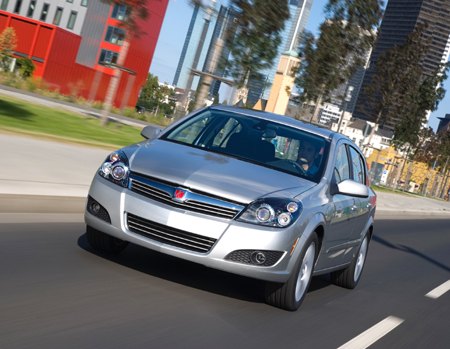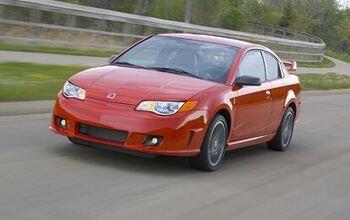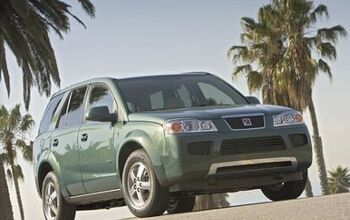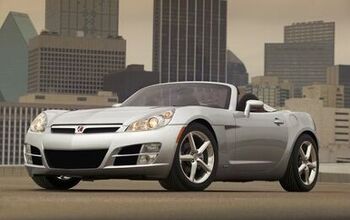Saturn Astra Review
“GM has never sold a competitive small car in America.” Not true. The imported rear wheel-drive Opel 1900– the sedan version of the Manta– was a superb machine for its day. Unfortunately, a rising dollar and a lack of marketing and development vis-a-vis the Japanese competition (Datsun 510) doomed the 1900 to footnoted obscurity. And now, once again, General Motors NA turns to Opel to get back in the small car game. They've brought over the Eurozone’s best selling passenger car: the Astra. Starting this January, you can buy an Astra in America, only with the logo swapped from Opel’s lightning bolt to Saturn’s rings. Should you?
The Astra’s exterior is no more ground breaking than Dunkin Donuts’ Gingerbread latte. While I wouldn’t call the Astra boring, it’s an entirely familiar design. I’m thinking a squared off Golf/Rabbit, or a slightly more muscular Mazda3. More importantly, the Astra’s not available as a sedan or coupe. America-friendly body styles have been eschewed for a racy three-door hatchback and a more traditionally proportioned five-door hatch. How great (a.k.a. expedient) is that?
The Astra’s interior, however, is worth the international intrigue. Again, it’s not particularly exciting. You might even say the Astra’s cabin is a piece of cold coal. I’m sure Alice Cooper picked the grey and darker grey color scheme. But the basic design is sharp (especially the crease down the middle of the center stack), modern and clearly Germanic (Das ist ein Opel, nicht wahr?), complete with bright orange interior lights. The fit and finish is at the very top of the segment, at least as good as this writer’s VW GTI and, in many cases, superior.
But the interior’s construction is missing creature comforts, leaving you asking uncomfortable cross-cultural questions. Why is there no center armrest? Why is there one puny, small, out of the way cupholder that couldn’t fit a shot glass (never mind the U.S.-requisite Big Gulp). Why does the clock display only 24-hour time? Why is the multifunction display so confusing? Ergonomically, the Astra’s papers are also not in order. The hatch looks nice, but why is the opening such an inconvenient shape?
Saturn’s PR has an explanation for this lack of naturalization. In fact, the press materials chide picky anal retentive reviewers before they can even get warm-up their OCD-o-meter. This isn’t a car for multitasking. This is a car for driving! Dummkopf! That’s a tacky, spin-cycle explanation, but hey, with that in mind, let’s take GM’s latest, greatest foray into compactcarhood for a spin.
You can have any engine you like as long as it’s a 1.8-liter four-cylinder powerplant with a genuinely underwhelming 138 horses. I’ll skip the usual lack of diesel diatribe, in large part because there’s no particulate reason to single out GM in this regard, and the zippy little engine really is quite good. Zero to sixty takes… probably between nine and ten seconds, and that’s enough for your small car isn’t it? Perhaps, if someone wasn’t trying to sell it to me as an enthusiasts’ driving machine…
The majority of American Astras will be equipped with an four-speed automatic transmission bereft of any manual lockdown. Sure that’s fine for most people, but why does Saturn keep telling me this is a car to “make a trip around the block exciting?” If you insist on an enthralling cicrumnavigation, you can opt for a first rate five-speed stick.
And I really shouldn’t cavil; the Astra drives superbly. The helm imparts such a premium feel that I started to get nervous that it might best my GTI in premiumfeelosity. The Astra’s steering has laser guided precision. Feedback? Enough to know where you’re going, but not so much to vibrate your hands off. Think mid 1990s BMW.
If the rest of the car is the Burger, the suspension is the King. There are “sport-luxury” cars in the $30k range that don’t ride like the Astra. Zero body roll in cornering, and still totally forgiving over rough pavement. I wrung the life out of my little tester without once becoming a person of interest. Even through a tight slalom, the Astra was nonplussed. Talk about confidence. It may as well have looked me in the eye, insulted my mother and lit up a cigarette.
Taken as a whole, the Saturn née Opel Astra falls between two stools. It’s not quite as sporty as the Mazda3 or MINI Cooper. It’s not quite as cushy as the Corolla or Civic. Its closest competitor is the VW Rabbit, and the best selling Rabbit is the Jetta. The Astra’s got a great price (so great that GM will lose money on every single one), but the lack of creature comforts, hatch-only configurations and decidedly unsporty spec-sheet will put most of its potential customers in other dealerships. Once again, a great car is doomed to failure.
Latest Car Reviews
Read moreLatest Product Reviews
Read moreRecent Comments
- Wolfwagen Pennsylvania - Two long straights, 1 medium straight, 1 super short straight and a bunch of curves all on one end
- Haze3 EV median weight is in the range of 4500-5500lbs, similar to the low end of full size pickup trucks and SUV's or typical mid-size PU's and SUV's. Obviously, EV Hummers and PU's are heavier but, on average, EV=PU or mid/full SUV is about right. EV's currently account for ~1% of the cars on the road. PU's account for 17% and SUV's count for over 40%. If we take out light SUV's, then call it 30% SUV or so. So, large-ish PU's and SUV's, together, account for ~50% of the US fleet vs 1% for EV's. As such, the fleet is ALREADY heavy. The problem is that EV's will be making the currently lighter 50% heavier, not that PU/SUV haven't already done most of the damage on avg mass.Sure, the issue is real but EV responsibility is not. If you want to get after heavies, that means getting after PU/SUV's (the current problem by 40-50x) first and foremost.
- Redapple2 Telluride over Acadian (sic-tip cap-canada). 1 better car. 2 60 % us/can content vs 39 THIRTY NINE for an "American" car. 3 no UAW labor. Smart people drive Tellurides. Not so smart for the GMC. Dont support the Evil GM Vampire.!
- Theflyersfan My dad had a 1998 C280 that was rock solid reliable until around 80,000 miles and then it wasn't. Corey might develop a slight right eyelid twitch right about now, but it started with a sunroof that leaked. And the water likely damaged some electric components because soon after the leaks developed, the sunroof stopped working. And then the electrical gremlins took hold. Displays that flickered at times, lights that sometimes decided illumination was for wimps so stayed home, and then the single wiper issue. That thing decided to eat motors. He loved that car but knew when to fold the hand. So he bought a lightly used, off lease E-class. Had that for less than two years before he was ready to leave it in South Philly, keys in the ignition, doors unlocked, and a "Take it please" sign on the windshield. He won't touch another Benz now.
- Detlump A lot of people buy SUVs because they're easier to get in and out of. After decades of longer, lower, wider it was refreshing to have easier ingress/egress offered by an SUV.Ironically, the ease of getting in and out of my Highlander is very similar to my 56 Cadillac.





































Comments
Join the conversation
It was such shame that GM gets so much wrong. In the UK where the astra was designed and made by Vauxhall not Opel the had a couple of nice turbo engines 1995 cc turbo which had 190 bhp and front and rear arm rest. Next the cup holder well it takes a standard can or bottle of coke, we do not have these large unhealthy drinks you have in the states so maybe GM was trying to look after your health
I've been looking at less expensive, smaller used cars. Should I consider a used Astra with low miles? Like another poster before, I don't need a lot of power that I'm not going to use here in Chicago (Thanks, Rahm, for all the $$$$ cameras), and I'm usually only hauling around a skinny little 7 year old grandson ..